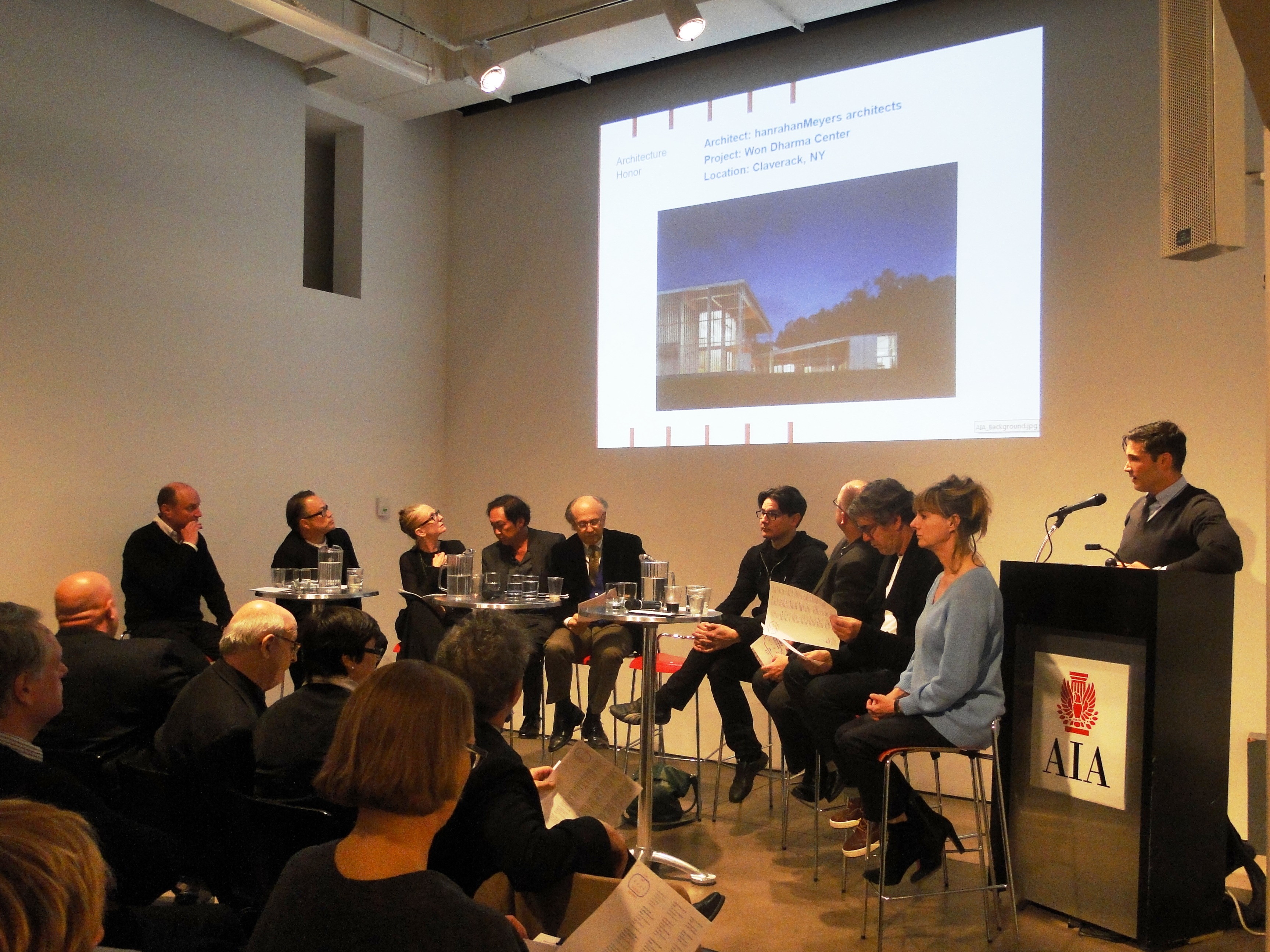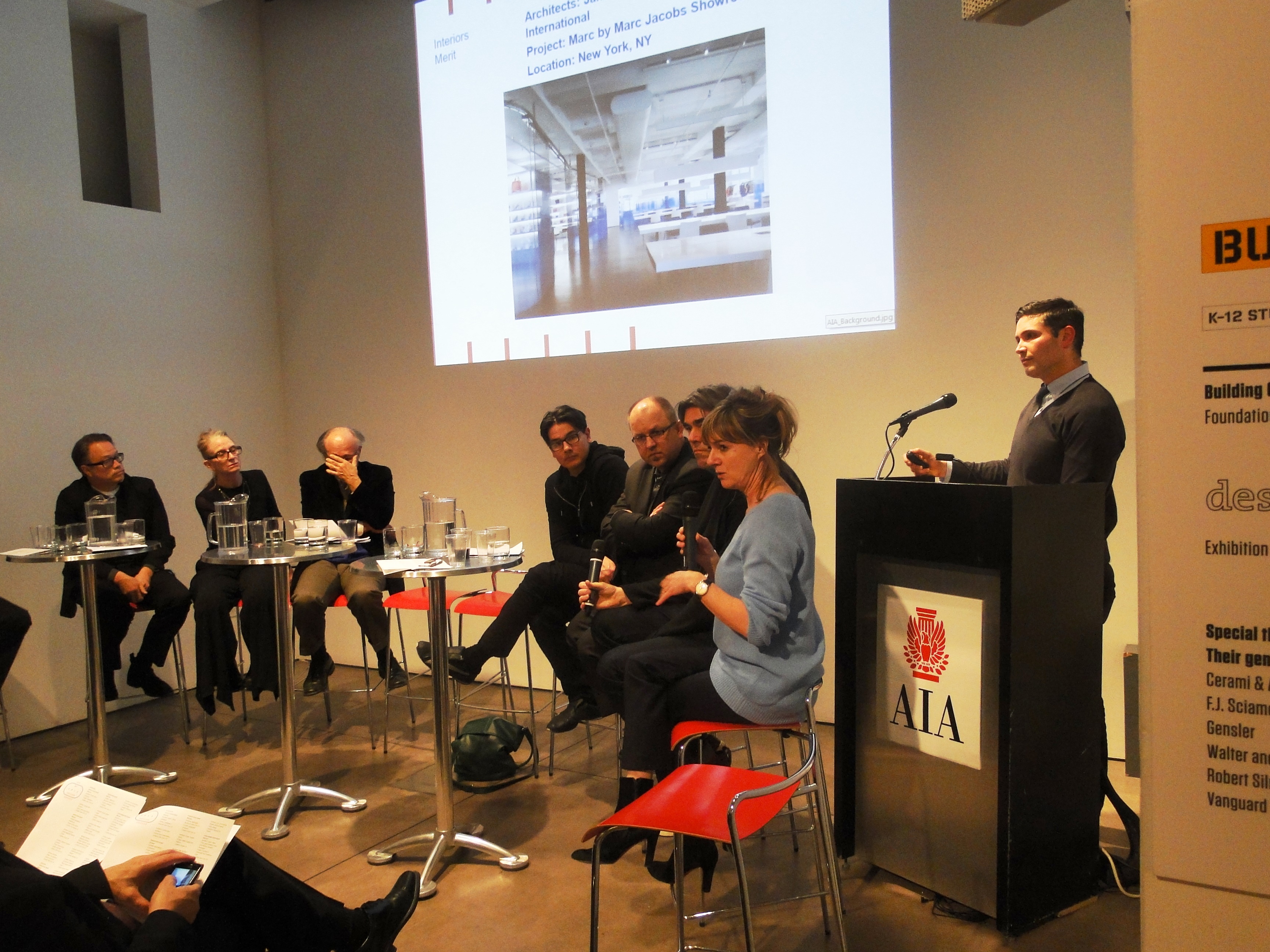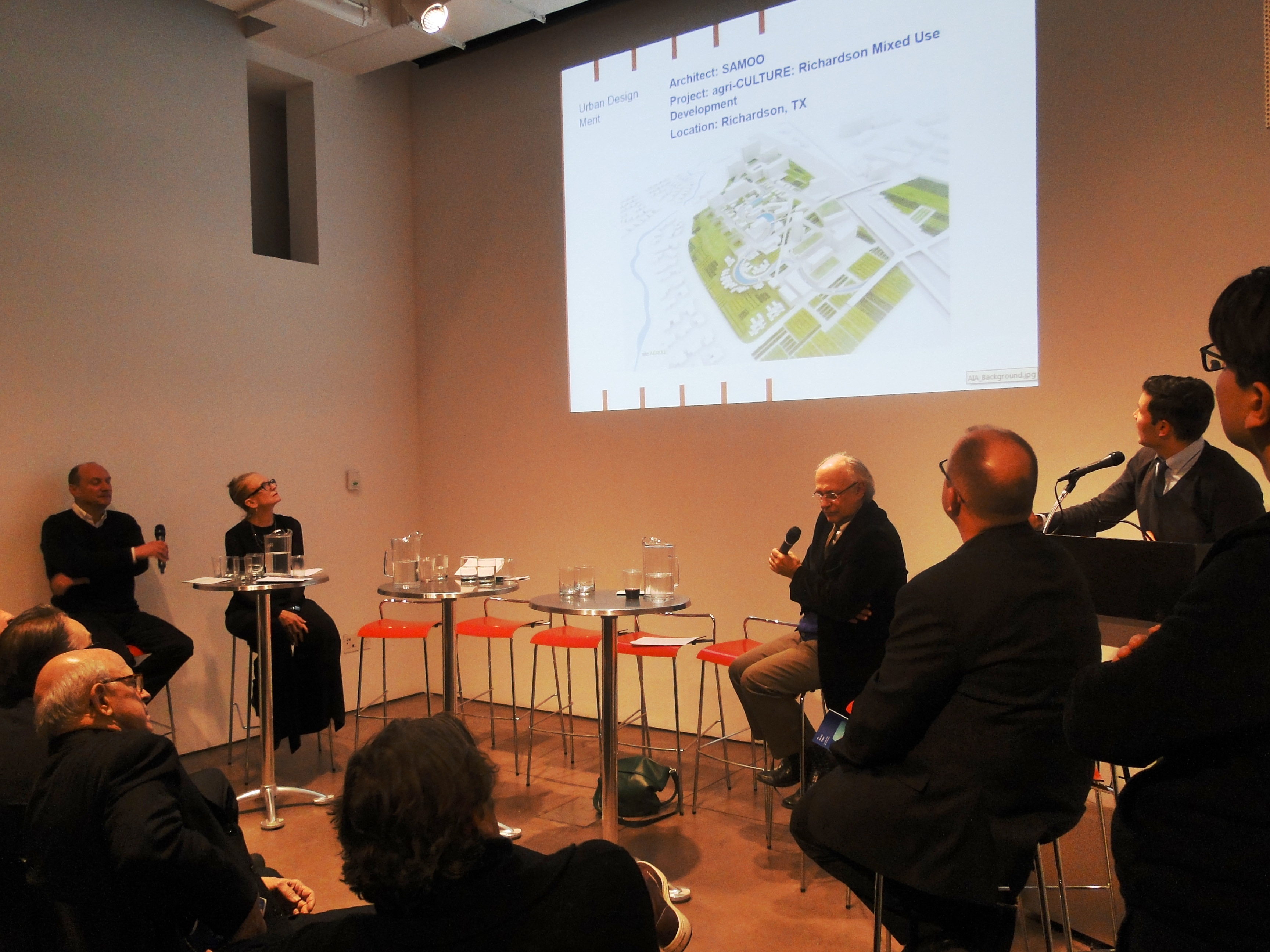by: Bill Millard
This year’s AIA New York Design Awards were distributed widely between large and small firms, between usual suspects and newcomers, and between high-profile, headline-grabbing projects and lesser-known, quietly impressive ones. Last Monday’s announcement of the winners – 21 in the Architecture category, six in Interiors, eight in Projects, and seven in Urban Design – demonstrated how New York’s architectural community expresses design excellence diversely, balancing attention to aesthetics, technical details, urban quality of life, and environmental responsibility. As Architizer founder Marc Kushner, AIA, guided the discussion with succinct, probing questions, the Juror Symposium offered frank insights into the strengths, contexts, and ambitions of these built and imagined projects.
In keeping with the theme set by this year’s 2013 AIANY President Jill Lerner, FAIA, “Global City, Global Practice,” the locally-based winners are counterbalanced by substantial overseas projects. Along with formally aggressive works at the skyscraper scale such as RUR Architecture’s O-14 Tower in Dubai (an Honor Award recipient in Architecture), Steven Holl Architects’ Sliced Porosity Block in Chengdu, China (Merit), and Skidmore, Owings & Merrill’s (SOM) Al-Hamra Tower in Kuwait City (Merit), jurors recognized medium-scale works like Richard Meier & Partners’ Jesolo Lido condominium in Italy (another Architecture Honor winner – in “one color,” Lawrence Scarpa, FAIA, drolly noted), and NADAAA’s strikingly striated Model Home Gallery in Seoul (Architecture Merit). Another Holl building, the Daeyang Gallery and House in Seoul, with E.rae Architects (Architecture Honor), offered ample gallery space yet “respected the scale of the neighborhood… every corner was really quite stunning,” as Scarpa observed. In assessing the balance between execution and ideas, he continued, “There’s no such thing as a good idea. Right, Bruce?” Juror Bruce Kuwabara, AIA, responded, “That’s what we agreed on. There’s only good expression.”
Projects Honor-winner Kápolna Madaras, an unbuilt secular-chapel design by Christopher Johnson Architect with Ramona Albert for the village of Mădăraș, Harghita, Romania, drew praise as the only unanimous choice in the category; with “renderings getting so good it’s hard to tell” from a realized building, according to Eric Höweler, AIA, LEED AP, plus impressive technical drawings, Kápolna Madaras “challenges assumptions about what a chapel is.”
The adaptive reuse of New Holland Island in St. Petersburg, Russia (Urban Design Merit), one of two winners by WORKac, weaves park space and new cultural facilities, including a bold spherical structure, among the huge flying buttresses of brick warehouses on two sides of a challenging, iconic triangular site, creating what juror David Coomes hailed as “the absolute counterpoint of the treatment inside this mini-citadel within a larger space.”
The Qingdao Harborfront in Shangdong, China, by EE+K a Perkins Eastman Company (Urban Design Honor) earned Alex Krieger, FAIA’s strong admiration: he noted that “if you try to reduce a city to one image, you’re probably not producing very good urbanism anyway,” but that close examination of EE+K’s site plan reveals sophisticated “levels of inventiveness, articulation, and special spaces that occur all along the edge of this waterfront,” arranged along a central spine that functions as both a room and a transit system.
Closer to home, several of New York’s newest icons won recognition, including the long-awaited realization of Louis Kahn’s decades-old design for Four Freedoms Park on Roosevelt Island (Urban Design Merit). This memorial by Kahn, David Wisdom, and Mitchell | Giurgola Architects, as Kushner challenged jurors to explain, overcomes the risk of overt sentimentality through what Kathryn Gustafson, ASLA, described as a highly spiritual progression across subtle changes in the ground plane, ending with “solid granite surrounded by living water” to evoke both the difficult attainment of FDR’s essential freedoms and those values’ endurance amid flux.
A widely recognized success within the Atlantic Yards master plan, Barclays Center by SHoP Architects and Ellerbe Becket/AECOM (Architecture Honor), struck Scarpa as “one of the best sports venues built in a really long time,” overcoming the all-too-frequent insularity of this typology and fitting surprisingly well into its setting. Kushner challenged jurors to discuss giving the “stamp of architectural approval to architects who took a risk and weren’t too concerned about the controversy”; Scarpa noted that “nothing good is going to go without some risk,” and that Barclays serves as “a fabric building, a connector within the city.”
Preservation projects drew special attention as a tricky type to present and document, but a critical contribution to urban continuity. SOM’s adaptation of 510 Fifth Avenue (Architecture Merit), repurposing Gordon Bunshaft’s landmarked Manufacturers Trust building for clothing retail, overcame a different type of controversy. “Programmatically, there couldn’t have been a greater degree of change,” commented Scarpa, “and yet the architect retained the essence of what was there – the key elements … [the adaptation still] has a lot of the grandeur of the original building.”
In the Interiors category, Guerin Glass Architects’ LifeEdited 1 (Honor) used moving walls and other flexible multipurpose components, telescoping about 1,300 square feet of functional program area down into a 400-square-foot residential space, to show how “constraints… make architects think better and think harder,” in juror Amanda Levete’s phrase, about what components of personal life are essential or expendable. This do-more-with-less project preceded Mayor Bloomberg’s “micro-apartment” project, Kushner noted, and may have been a prototype for it, as what juror Andrew Wells, FAIA, called “part of a media assault on a new way of living…. It’s great to see architecture being rewarded for trying to move the needle on social issues.”
Others in this category included Toshiko Mori Archhitect’s Sean Kelly Gallery (Interiors Honor), distinguished for light control and an elegant library space (external to its official image); WORKac’s bright orange, net-floored Children’s Museum of the Arts (Interiors Merit – “The net is the most innovative feature of all the projects we saw all day. Eyes on the street in a new way.”); and EwingCole’s Bayhealth Medical Center in Dover, Delaware (Interiors Merit), hailed by Clive Wilkinson, AIA, for its “very organic play with light and space” amid the rigorous program demands of a medical facility. Among Projects honorees, Cooper Joseph Studio’s Webb Chapel Park Pavilion in Dallas (Projects Merit), described by Marlon Blackwell, FAIA, as “a building upside-down, almost,” meets the ground with the daring asymmetry of three short support walls, and casts a stark, powerful concrete profile against the sky.
Kuwabara, who visited several local entries personally after arriving in New York for the deliberations, singled out Kohn Pedersen Fox’s One Jackson Square (Architecture Honor,) for “different levels of reflectivity… and transparency that you have to be outside the building to sense; you don’t get it from a single photograph.”
That concern with immediate, tangible experience over photographic polish informed several decisions and discussions. Despite the recurrently cited constraint of relying on a single image for each project (an organizational inevitability, given the total of more than 400 entries), the jurors recalled an animated process of consensus formation. Certain border-pushing entries, they acknowledged, overcame intra-panel objections, or reservations about what Gustafson called “rather unfortunate” renderings, on the strength and timeliness of their concepts. Though the neologism “urbaneering” struck Coomes as unnecessary, Terreform One’s Urbaneer Resilient Water Infrastructure (Urban Design Merit), a vision for flooding mitigation, energy self-sufficiency, and zero-carbon urbanism in Brooklyn, earned approval for what Gustafson termed “a new way to look at the city… it is urban, but it’s not about buildings so much as systems.” Whether or not its interventions (e.g. using fragments of broken ships as bulwarks against storm surges, making the city’s borders spongier) are properly termed architectural, she convinced her colleagues that they add to the health of a city.
Kushner recalled “a theme that I heard from many of the jury members: that it was about creating a story, in a clear concise way, that the jury could set into it and understand the decision making of the architect.” The most immediately compelling of those stories distinguished these 42 entries from their competitors, yet as more buildings are realized, some will take longer to get their messages across. “There are probably projects that didn’t get awards but will get them eventually,” Scarpa said. “We looked for something extra-special… our determining factor was that had to it move you in a special way, and not just be a really good building.”
Event: AIANY Design Awards 2013 Juror Symposium
Location: Center for Architecture, 03.04.2013
Speakers: Marc Kushner, AIA, partner and co-founder, HollwichKushner, and CEO of Architizer.com (moderator); Jill N. Lerner, FAIA, president, AIANY (introduction); Rick Bell, FAIA, executive director, AIANY. Jurors: Ann M. Beha, FAIA, Ann Beha Architects (in absentia), Bruce Kuwabara, AIA, founding partner, KPMB Architects, Toronto, and Lawrence Scarpa, FAIA, Brooks + Scarpa (Architecture); Amanda Levete, principal, AL_A, Andrew Wells, FAIA, LEED AP, co-founder of Deke Wells Architecture, Springfield, Missouri, and Clive Wilkinson, FAIA, RIBA, Clive Wilkinson Architects, Los Angeles (Interiors); Michelle Addington, associate professor, Yale School of Architecture, Marlon Blackwell, FAIA, distinguished professor, School of Architecture at the University of Arkansas, and Eric Höweler, AIA, LEED AP, founding principal, Höweler + Yoon, and assistant professor, Harvard Graduate School of Design (Projects); David Coomes, principal and managing director, EDCO Design London Limited Alex Krieger, FAIA, founding principal, Chan Krieger & Associatees, and professor, Harvard Graduate School of Design, and Kathryn Gustafson, PLA, ASLA, Hon. FRIBA, founding partner, Gustafson Guthrie Nichol, Seattle, and Gustafson Porter, London (Urban Design)
Organizer: AIANY












